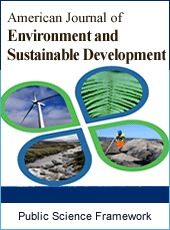American Journal of Environment and Sustainable Development
Articles Information
American Journal of Environment and Sustainable Development, Vol.4, No.1, Mar. 2019, Pub. Date: Apr. 17, 2019
Pilot Study of “EG Mosquito Repellent Bracelet” for Malaria Vector Control in Selected Communities in North-Central Nigeria
Pages: 38-42 Views: 1900 Downloads: 431
[01]
Joel Akilah, National Malaria Elimination Programme, Federal Ministry of Health, Abuja, Nigeria.
[02]
Ibanga Ekong, Department of Community Health, University of Uyo, Uyo, Akwa Ibom, Nigeria.
The National Malaria Elimination Programme conducted a mini-pilot study, in One-Man village and New Nyanya, both in Karu Local Government Area of Nasarawa State, on the EG Mosquito Repellent Bracelet to determine its efficacy as an innovative technique for vector control. Advocacy visits were carried out to the community leaders while verbal consents were obtained from adult members of the households where the product was deployed. Households were randomly selected from each community. The EG Mosquito Repellent Bracelets were issued to identified adult members of each household in each community. Baseline entomological survey was carried out using structured questionnaires, inter personal communication (IPC) with occupants and Pyrethrum Spray Catch (PSC). The baseline data showed that the indoor resting density (IRD) ranged from 1.2/room/man in One-Man village to 2.2/room/man in New Nyanya and that a few of the Anopheles mosquitoes caught were fed with human blood meal in both sites (IRD of 1.0 and 1.6 in One Man village and New Nyanya, respectively). Furthermore, between 73% - 80.9% of Anopheles mosquitoes collected were fully fed. Post intervention entomological monitoring showed that no Anopheles mosquitoes were caught in the households sampled 48 hours after the EG Mosquito Repellent Bracelets were deployed. Anopheles species were caught on subsequent days of the entomological monitoring, with the highest number on day 7, showing increase in indoor resting density. However, fewer fed mosquitoes were caught from both sites compared to baseline data.
Mosquito Repellent, Bracelets, Malaria, Vector Control
[01]
World malaria report 2017. Geneva: World Health Organization; 2017. Licence: CC BY-NC-SA 3.0 IGO.
[02]
National Malaria Strategic Plan 2014 – 2020. Federal Ministry of Health, Nigeria; 2014.
[03]
National Malaria Elimination Programme (NMEP), National Population Commission (NPoPC), National Bureau of Statistics (NBS), and ICF International, 2016. Nigeria Malaria Indicator Survey 2015. Abuja, Nigeria, and Rockville, Maryland, USA: NMEP, NPoPC, and ICF International.
[04]
Durrheim D. N. Govere J. M., 2002. Malaria outbreak control in an African village by community application of ‘deet’ mosquito repellent to ankles and feet. Med. Vet. Entomol. 16: 112–115.
[05]
Patel EK, Gupta A, Oswal RJ. 2012. A review on: mosquito repellent methods. Int. J. Pharm. Chem. Biol. Sci. 2: 310–317.
[06]
Potter CJ 2014. Stop the biting: targeting a mosquito's sense of smell. Cell 156: 878 – 881.
[07]
Debboun M, Strickman D. 2013. Insect repellents and associated personal protection for a reduction in human disease. Med. Vet. Entomol. 27: 1–9.
[08]
Rodriguez SD, Drake LL, Price DP, Hammond JI and Hansen IA. The Efficacy of Some Commercially Available Insect Repellents for Aedes aegypti (Diptera: Culicidae) and Aedes albopictus (Diptera: Culicidae). Journal of Insect Science, Volume 15, Issue 1, 1 January 2015, 140.
[09]
Fradin MS, Day JF. 2002. Comparative efficacy of insect repellents against mosquito bites. N. Engl. J. Med. 347: 13–18.
[10]
Fuss SH, Omura M, Mombaerts P. 2007. Local and cis effects of the H element on expression of odorant receptor genes in mouse. Cell 130: 373–384.
[11]
Fuss SH, Zhu Y, Mombaerts P. 2013. Odorant receptor gene choice and axonal wiring in mice with deletion mutations in the odorant receptor gene SR1. Mol. Cell Neurosci. 56: 212–224.
[12]
Hill N, Lenglet A, Arnez AM, Carneiro I. 2007. Plant based insect repellent and insecticide treated bed nets to protect against malaria in areas of early evening biting vectors: double blind randomised placebo controlled clinical trial in the Bolivian Amazon. bmj 335: 1023.
[13]
Rodriguez SD, Drake LL, Price DP, Hammond JI, Hansen IA. 2015. The efficacy of some commercially available insect repellents for Aedes aegypti (Diptera: Culicidae) and Aedes albopictus (Diptera: Culicidae). J. Insect. Sci. 15.

ISSN Print: Pending
ISSN Online: Pending
Current Issue:
Vol. 6, Issue 4, December Submit a Manuscript Join Editorial Board Join Reviewer Team
ISSN Online: Pending
Current Issue:
Vol. 6, Issue 4, December Submit a Manuscript Join Editorial Board Join Reviewer Team
| About This Journal |
| All Issues |
| Open Access |
| Indexing |
| Payment Information |
| Author Guidelines |
| Review Process |
| Publication Ethics |
| Editorial Board |
| Peer Reviewers |


